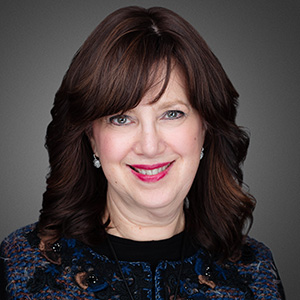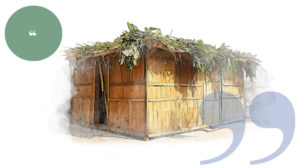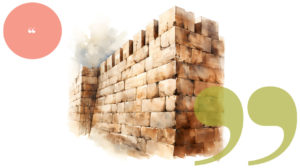My Home, My Place

Acceptance means viewing the package as good, even if it is far from perfect

I always found it hard to relate to those people who didn’t want to get out there and see the world, for whom travel was synonymous only with packing, security lines, an upset stomach, and jet lag. To me, the world is an exciting place, waiting for me to explore it, the price of which is some degree of inconvenience.
Nonetheless, more recently I’m finding that the best part of going away is coming home to my house, my bed, my place. Is my deep sense of peace at coming home more than just the joy at having a place to rest my weary bones?
The theme of makom, or place, is prominent in our calendar, especially as we continue the cycle of events that started with the tragedies of Tammuz and Av, move into the reflection of Elul, and determine a course for the new year in Tishrei. Returning to our homes after Succos, we can recommit to building a place where the entire family can thrive.
A Loss of Place
Rav Moshe Shapiro describes the loss of the Beis Hamikdash and the ensuing exile of the last 2,000 years as a loss of place. We went to the Beis Hamikdash to recharge, to see and be seen by the One who created us, to refocus and center our priorities. When it was destroyed, we lost our sense of rootedness on the deepest level. Our physical wanderings from continent to continent reflect an unsettled state of being, in which it’s hard to maintain the picture of who we are.
This can all be summed up succinctly in the statement “Ein lecha davar she’ein lo makom — There is no thing that doesn’t have its place” (Avos 4:3). On the simplest level, this means that everything Hashem created has a place in which it thrives, a place necessary for its existence. Did you ever pass a homeless person on the street? Survive he may, but one would not say that in that condition he thrives.
Rav Shapiro delineates three different aspects of this concept.
- Makom is related to kiyum, existence. We refer to Hashem as Hamakom, alluding to the idea that His place is not the world, but rather the world is His place.
- Makom is also used in the sense of mimalei makom— to fill the place or the position of someone.
- Finally, it is used in the sense of lakum al, to rise up and overpower that which must be overcome.
Putting these definitions together, from the time that we lost the Beis Hamikdash, our very existence has been on shaky ground (the first definition). We never really belong in any place, and our spiritual growth is stunted (the second definition). And the loss of place inhibits our ability to overcome our enemies (the third definition). No matter where we are, there is someone who says we should be somewhere else.
A Substitute Mikdash
Yet we go on, even in exile, and have families and homes. Is there a level on which a bayis can provide some of what we had in that original makom in Yerushalayim, the Beis Hamikdash?
There is, and we see a hint to this in a statement in the Talmud: “Miyamai lo karasi l’ishti ishti, ela karasi l’ishti beisi — I never called my wife my wife, I called her my house” (Shabbos 118b). This profound statement indicates that a Jewish home based on Torah has the ability to become a makom in all senses of the word, to be a bayis like the Beis Hamikdash.
Through our homes, we can overcome the challenges that surround us. We have a place that is spiritually centering, a place to recharge, a place in which we can be who we are meant to be.
Whether or not our home serves as that makom has much to do with our mindset and the choices we make while continuing to build that most important relationship within its walls. One critical aspect of that mindset is acceptance.
When I worked with kids at risk, I encountered many adolescents who wanted to leave home. Many felt that their home was not their place and that there was no place for them in their home. They felt a lack of acceptance — of their uniqueness, their desire for expression, and their individual challenges.
A home has to be a place in which each person, whether adult or child, can see that he or she is important and needed. Like the Beis Hamikdash, it must be a place a person feels seen and accepted, and where it’s possible to be forgiven for one’s mistakes. Only then can one recalibrate and refocus.
I recently met a couple who has had a challenging marriage for many years. Coming from different cultures and lacking good communication skills, there’s an almost continuous state of tension in the home. As their last child was getting married, the husband’s brother approached him. “Now that it’s going to be just the two of you, how are you going to manage?”
The husband looked at his brother in confusion. “What do you mean?”
“You know, the constant arguing between you and your wife…”
“Oh, that,” replied the husband. “That’s okay. My wife is nervous, and sometimes I can be tough, but she’s my wife and she is a good person.”
Acceptance means viewing the package as good, even if it is far from perfect. It’s not my job to fix my spouse, only to fix myself and to work on our relationship.
Beyond the Four Walls
What about forgiveness? We went to the Beis Hamikdash to atone for the mistakes, even the very serious ones, that we made. We knew there was a process and a venue in which forgiveness could be had. Can the same be said of our homes, or are old wrongdoings regularly brought down off the shelf, dusted off, and held up for inspection all over again? Is there a way that our spouses or children can be truly forgiven by us? Is what we are asking for in the process reasonable?
Keep in mind that the home is not just four walls where a family lives, but rather something much bigger. Like the Mikdash, we are creating a home for the Shechinah to dwell. We accomplish this in so many little ways. Take, for example, the tone of voice spoken by the people of the home.
Were you ever standing at the Kosel trying to daven when the woman behind you was talking loudly on her cell phone? Imagine if you were in the Beis Hamikdash itself. How incongruous would loud chatter be? We can be comfortable in our homes and still maintain a sense of the dignity of the place. We can try speaking more quietly for emphasis, rather than more loudly.
Just as the Mikdash was a place in which we felt enveloped and nurtured by the presence of the Shechinah, so too we must make an effort to set up our homes in a way that will nurture us on every level. Simple things like painting your bedroom a color that makes you happy can add to the sense of home as sanctuary. A comfortable pillow, a chair where you can read, think, or daven all help. Even with kids around, a sense of order, the sense that things have a place, helps us make our homes like the Beis Hamikdash, in which each vessel had a designated place.
On Succos, we leave our homes to sit with Hashem in the succah and celebrate the joy we have achieved in our relationship with Him. We look through the sechach and remind ourselves that wherever we are, our real place is with Him. After Yom Tov, our mission is to bring Him into our homes by continuing to work on our marriages and finding joy in them, and creating a miniature Mikdash for our families.
(Originally featured in Family First, Issue 461)
Oops! We could not locate your form.












